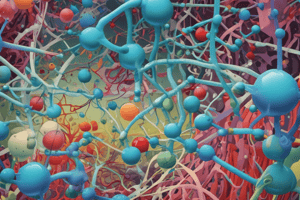Podcast
Questions and Answers
Which of the following is a type of enzyme that can be regulated by altering its activity?
Which of the following is a type of enzyme that can be regulated by altering its activity?
- Isoenzyme
- Holoenzyme
- Apoenzyme
- Allosteric Enzyme (correct)
What is the purpose of feedback inhibition in enzyme regulation?
What is the purpose of feedback inhibition in enzyme regulation?
- To decrease the activity of an enzyme (correct)
- To convert a proenzyme to an active enzyme
- To modify the structure of an enzyme
- To increase the activity of an enzyme
What is the term for the process of converting an inactive proenzyme into an active enzyme?
What is the term for the process of converting an inactive proenzyme into an active enzyme?
- Activation
- Proteolysis (correct)
- Denaturation
- Protein modification
Which of the following is an example of protein modification?
Which of the following is an example of protein modification?
What is the advantage of modifying the activity of an existing enzyme rather than synthesizing a new one?
What is the advantage of modifying the activity of an existing enzyme rather than synthesizing a new one?
What is the primary advantage of changing the activity of a pre-existing enzyme?
What is the primary advantage of changing the activity of a pre-existing enzyme?
Which of the following mechanisms of enzyme regulation involves the binding of a molecule to a non-active site on the enzyme?
Which of the following mechanisms of enzyme regulation involves the binding of a molecule to a non-active site on the enzyme?
What is the purpose of proenzymes in the regulation of enzyme activity?
What is the purpose of proenzymes in the regulation of enzyme activity?
Which of the following types of regulation is a slow and long-term response to changes in the cellular environment?
Which of the following types of regulation is a slow and long-term response to changes in the cellular environment?
Which of the following mechanisms of enzyme regulation involves the covalent modification of an amino acid residue on the enzyme?
Which of the following mechanisms of enzyme regulation involves the covalent modification of an amino acid residue on the enzyme?
Flashcards are hidden until you start studying
Study Notes
Enzyme Activity Regulation
- Modulating the activity of an existing enzyme in the cell is the fastest way to regulate enzyme activity.
Common Methods of Enzyme Regulation
- Allosteric Enzymes: a type of enzyme that can be regulated through allosteric interactions.
- Feedback Inhibition: a mechanism where the end product of an enzyme-catalyzed reaction inhibits the enzyme's activity.
- Proenzymes (Zymogen): an inactive precursor of an enzyme that can be converted to an active form.
- Protein Modification: a method of regulating enzyme activity through post-translational modifications, such as phosphorylation or ubiquitination.
Enzyme Activity Regulation
- Modulating the activity of an existing enzyme in the cell is the fastest way to regulate enzyme activity.
Common Methods of Enzyme Regulation
- Allosteric Enzymes: a type of enzyme that can be regulated through allosteric interactions.
- Feedback Inhibition: a mechanism where the end product of an enzyme-catalyzed reaction inhibits the enzyme's activity.
- Proenzymes (Zymogen): an inactive precursor of an enzyme that can be converted to an active form.
- Protein Modification: a method of regulating enzyme activity through post-translational modifications, such as phosphorylation or ubiquitination.
Studying That Suits You
Use AI to generate personalized quizzes and flashcards to suit your learning preferences.




